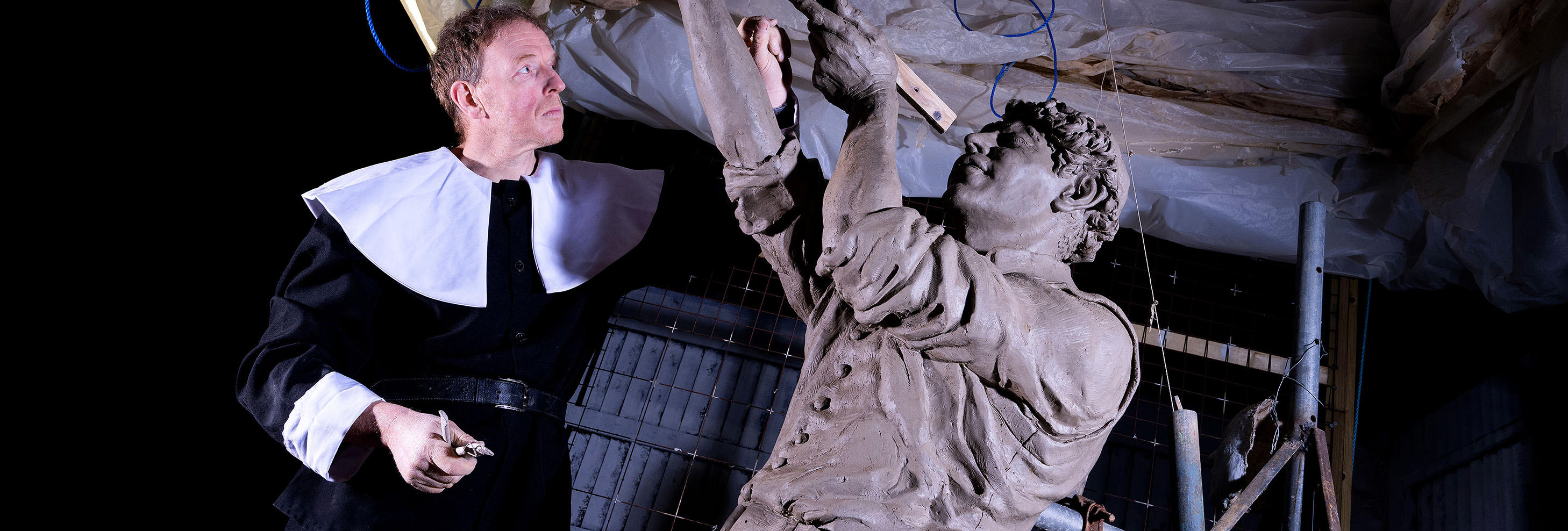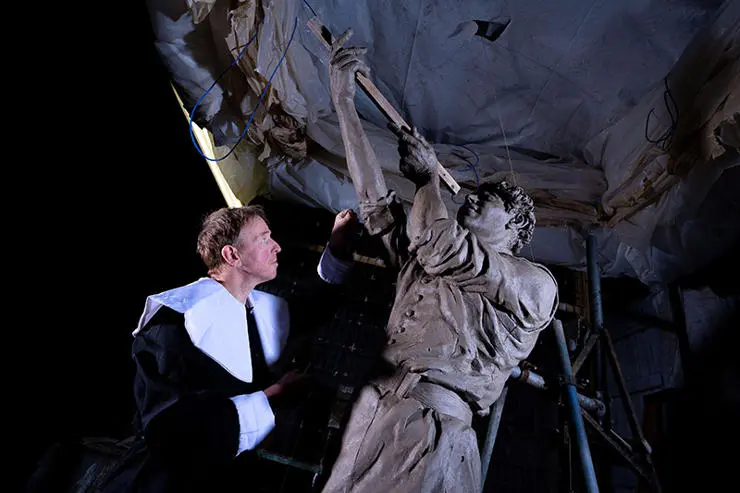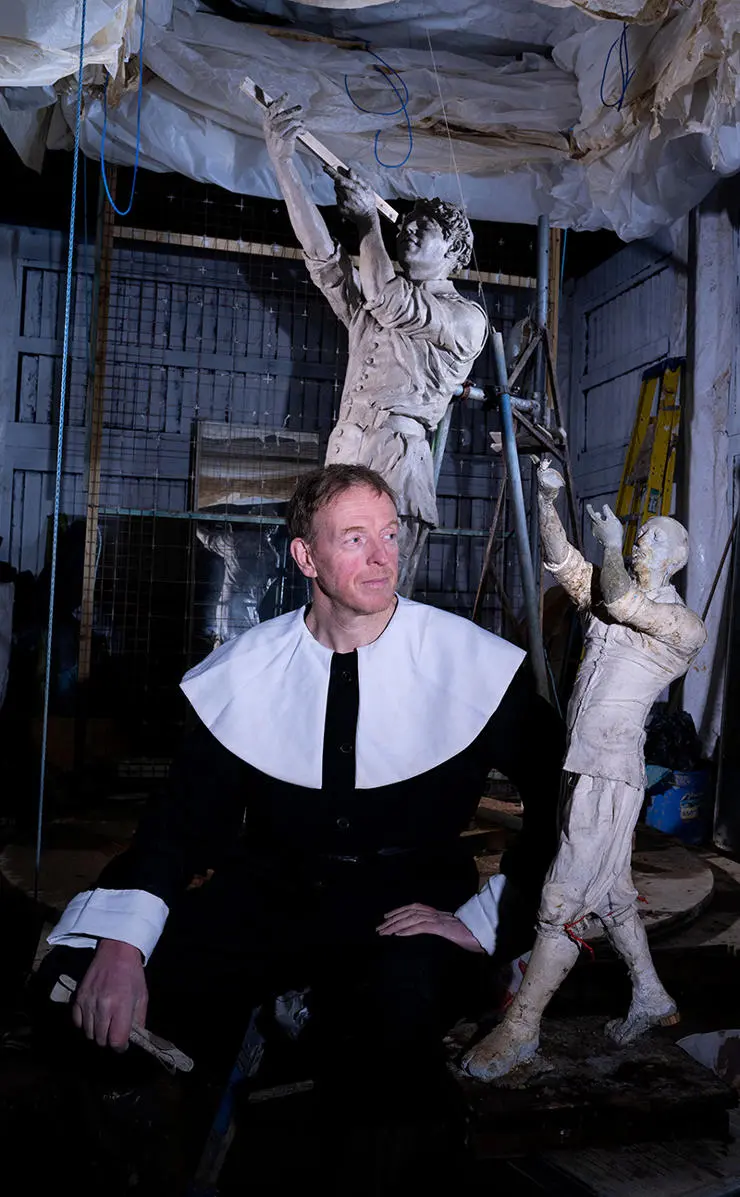UCLan commissions statue to honour unsung astronomer Jeremiah Horrocks
Revolutionary 17th century astronomer Jeremiah Horrocks has been reimagined for a modern audience by a Liverpool sculptor at the request of the University of Central Lancashire (UCLan).
Talented artist Phil Garrett has spent the last 12 months creating a 7ft 6inch clay sculpture of the man who, almost 400 years ago, was the first person to both predict and observe a transit of Venus.
This is an event whereby Venus is seen to pass in front of the face of the Sun, appearing as a dark shadow on the Sun. This enabled Jeremiah to estimate the size of the Solar System and prove that it is much larger than was previously thought, revolutionising our estimates of the vast scale of space.
"I’m passionate about celebrating Liverpool’s unsung heroes through my art and Jeremiah, who was born in Toxteth, was top of that list. "
— Artist Phil Garrett
The statue, which is one and a quarter life-size, was completed at UCLan after Phil was invited to sit as artist in residence by the University’s Jeremiah Horrocks Institute for Mathematics, Physics and Astronomy. The Institute was established in 1927, with the founding of the Jeremiah Horrocks Observatory in Moor Park to honour the local astronomer who observed the transit of Venus in 1639 in nearby Much Hoole, eight miles from Preston.
Phil said: “I’m passionate about celebrating Liverpool’s unsung heroes through my art and Jeremiah, who was born in Toxteth, was top of that list. I donated a miniature model of him to UCLan in 2014 so it feels like a natural progression to create this much larger version of the man.”
The 51-year-old used a measuring system practiced in Ancient Greece, known as linear enlargement, to scale up his model and then sculpt it around a metal frame using a quarter of a tonne of recycled clay.
Jeremiah’s face is based on the actor Nathan Morris, who played the astronomer in a 2012 travelling play about Jeremiah’s life entitled `The Transit of Venus’, and Phil even wore traditional dress of the time whilst sculpting to make sure he could capture the folds of the material in just the right way.
"We are delighted with Phil’s brilliant reimagining of one of the founding fathers of English astronomy. "
— Professor Derek Ward Thompson, Director of UCLan’s Jeremiah Horrocks Institute.
“I created six more designs after making my original miniature model and then began this final version seven months ago.” Phil said. “This latter stage is about refining the small details to get it just right.”
Professor Derek Ward Thompson, Director of UCLan’s Jeremiah Horrocks Institute, said: “We are delighted with Phil’s brilliant reimagining of one of the founding fathers of English astronomy.
“Jeremiah sadly died at the young age of 23 and is largely unknown outside of the local astrophysics community. Through this statue we hope to celebrate his accomplishments and introduce more people to the man who set the foundations for how we view the size of the universe.”
Phil’s model has now been captured in a silicon mould that can be used to cast the statue in bronze at a later stage and this clay model will soon be recycled.
"Our hope is to have a statue of Jeremiah as a permanent fixture on campus and constant reminder of a visionary who deserves his place alongside the greats such as Isaac Newton and Galileo."
— Professor Derek Ward Thompson, Director of UCLan’s Jeremiah Horrocks Institute.
Derek added: “Our hope is to have a statue of Jeremiah as a permanent fixture on campus and constant reminder of a visionary who deserves his place alongside the greats such as Isaac Newton and Galileo.”
Phil added: “UCLan has supported me throughout this project with resources and by providing the space to build a model on such a large scale. I don’t feel like I’m saying goodbye because the information of the sculpture is captured in the mould. I’m keen to do more work on Jeremiah and hopefully produce other versions of him, so this really is just the beginning.”
The artist, who developed a love for anatomical sculpture under the guidance of the late Liverpool sculptor Terry McDonald, hopes to continue his relationship with the Jeremiah Horrocks Institute by creating a bust of Moses Holden, a Preston astronomer and one of the founders of The Institute for the Diffusion of Knowledge (now UCLan) in 1828.





